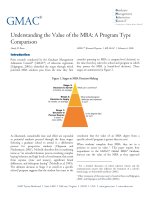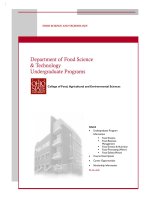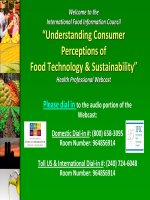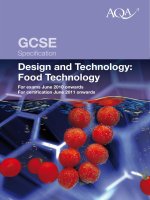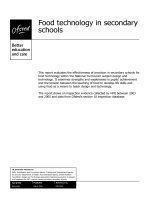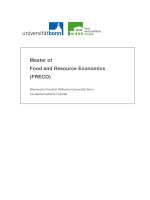“Understanding Consumer Perceptions of Food Technology & Sustainability” pdf
Bạn đang xem bản rút gọn của tài liệu. Xem và tải ngay bản đầy đủ của tài liệu tại đây (3.65 MB, 50 trang )
Welcome to the
International Food Information Council
“Understanding Consumer
Perceptions of
Food Technology & Sustainability”
Health Professional Webcast
Please dial in to the audio portion of the
Webcast:
Domestic Dial-in #: (800) 658-3095
Room Number: 964856914
Toll US & International Dial-in #: (240) 724-6048
Room Number: 964856914
Welcome
Marianne Smith Edge,
MS, RD, LD, FADA
Senior Vice President,
Nutrition and Food Safety,
International Food Information Coundil
International Food Information Council (IFIC)
and The Foundation
Mission: To effectively communicate science-based
information on food safety and nutrition issues to
health professionals, journalists, educators and
government officials.
Mission: To effectively communicate science-based
information on health, nutrition, and food safety for the
public good.
Primarily supported by the broad-based food, beverage,
and agricultural industries.
Today’s Speakers
• Lindsey Loving
Senior Director,
Food Ingredient &
Technology Communications ,
International Food Information Council
• Kerry Robinson, RD
Manager,
Food Ingredient &
Technology Communications,
International Food Information Council
Today’s Presentation
• Learning objectives
• Presentation of key findings from
IFIC Food Technology Survey
– Confidence in Safety & Labeling
– Plant & Animal Biotechnology
– Nanotechnology
– Sustainability
• Communication insights for health
professionals
• Question and Answer Session
Learning Objectives:
1. Hear insights from the 2010 IFIC Survey
regarding consumer perceptions of food
technology and sustainability
2. Identify consumer concerns and gaps in
information regarding food technology
3. Learn tips for communicating with
consumers about food technology in a way
that helps build awareness and
understanding
Please email all questions to:
•
– We will answer as many questions as we can
at the end of the webinar.
Also, you can:
• Follow us on Twitter at: @foodinsight,
#foodinsight
• View a PDF of the slides at:
/>spx?topic=2010_Consumer_Perceptions_of_Foo
d_Technology_Survey
IFIC’s 2010
“Consumer
Perceptions of
Food
Technology”
Survey
9
Survey Objectives
The purpose of this survey is to:
– Track awareness and perceptions of food
technology
– Reveal concerns, gaps in information, etc.
related to food biotechnology and
new/emerging technologies
– Measure the extent to which consumers’ views
of food technology change over time
– Identify benefits of food biotechnology that
resonate with consumers
This study has been conducted annually since 1997, except in 1998 when
no survey was conducted and in 1999 and 2001 when two surveys were
conducted per year.
METHODOLOGY
2010 2008 2007 2006 2005 and
prior
Population: U.S. adults
(18+)
U.S. adults
(18+)
U.S. adults
(18+)
U.S. adults
(18+)
U.S. adults
(18+)
Methodology: 100% web 100% web 100% web 50% web
50% phone
100%
phone
Data collection
period:
April 5 –
April 26
July 29 –
August 18
July 11 – July
27
June 21 – July
24
Sample Size
(error):
n=750
(+3.6 pp)
n=1,000
(+3.1 pp)
n=1,000
(+3.1 pp)
Web: n=497
(+4.4 pp)
Phone: n=503
(+4.4 pp)
n=1,000
(+3.1 pp)
Weighting: Data
weighted on
education
and marital
status to be
nationally
representat-
ive
Data weighted
on education
and marital
status to be
nationally
representative
Data weighted
on age and
education to
be nationally
representative
Data weighted
on race, age,
gender and
education to be
nationally
representative
Data
weighted
on
demograph
ic variables
to be
nationally
represent-
ative
Use of the term significant throughout the report refers to the statistical significance – meaning we are
95% confident that the change indicated in the sample exists in the total universe.
Confidence in the Food Supply
Very confident
Not at all confident
Somewhat confident
Not very confident
Q3. How confident are you about the safety of the US food supply? Would you say…?
Confidence in the Food Supply
Neutral
51%
50%
54%
18%
10%
9%
15%
18%
10%
3%
2%
Confident
Not confident
2008
2010
2007
19%
19% 20%
2%
Q4. What, if anything, are you concerned about when it comes to food safety? [OPEN END]
Percent concerned with each food safety issue (unaided):
2010 2008 Change
Disease/contamination
38% 50%
-12% pts.
Handling/preparation
33% 29%
+4% pts.
Food sources
11% 13%
-2% pts.
Preservatives/Chemicals
10% 6%
+4% pts.
Health/nutrition
9% 8%
+1%pts.
Agricultural production
9% 7%
+2% pts.
Packaging/labeling
5% 3%
+2% pts.
Biotech
2% 1%
+1% pts.
Processed foods
1% 1%
Other
4% 2%
+2% pts.
Food Safety Concerns
Q1. Thinking about your diet over the past few months, are there any foods or ingredients
that you have avoided or eaten less of?
Significantly fewer Americans are avoiding specific foods or
ingredients compared to 2007.
2010
Not
Avoiding
46%
Avoiding
54%
’07
2007
Not
Avoiding
39%
Avoiding
61%
Americans Avoiding Certain Foods
’08,
’07
51%
32%
18%
20%
16%
8%
2%
1%
14%
51%
36%
20%
15%
12%
4%
3%
1%
13%
0%
0%
Sugar/carbs
Fats/oils/cholesterol
Animal products
Salt/sodium
Snack foods/fast foods/soda
Artificial/additives
Spices
Processed/refined foods
Biotech
Other
2010
2008
Q 1b. [IF AVOIDED FOODS] What foods or ingredients have you avoided? [OPEN END]
Biotech foods do not
make the list of things
Americans are avoiding.
Types of Food Avoiding
Food Labeling
18%
14%
16%
18%
20%
20%
78%
79%
82%
84%
86%
82%
Q2. Can you think of any information that is not currently included on food labels that you would like
to see on food labels?
Q 2b. [IF YES] What types of information would that be? [OPEN END]
*Those who said "Nothing" or "Don‟t know" to Q10 were recoded as "No" answers in Q2.
Satisfaction with Current Food
Labels
In 2010, only 18% of Americans can think of information
they would like to see added to food labels. Only 3% of
Americans mentioned a desire to see biotech foods labeled.
Yes
No
’08
2010 2008 2007 2006 2005 2004
’05,
’04
’05,
’04
Q16. The U.S. Food and Drug Administration (FDA) requires special labeling when a food is produced under certain
conditions: When biotechnology's use substantially changes the food's nutritional content, like vitamins or fat, or
its composition; or when a potential safety issue is identified. Otherwise, special labeling is not required. Would
you say that you strongly support, somewhat support, neither support nor oppose, somewhat oppose or strongly
oppose this FDA policy?
The Majority of Americans
Support the FDA Labeling Policy
2010
Oppose
12%
Neutral
24%
Support
63%
Plant Biotechnology
More than two-thirds of
consumers have heard
at least “a little” about
food biotechnology, as
was the case in
previous years.
Q5. As you may know, some food products and medicines are being developed with the help of [OLD:
new] scientific techniques. The general area is called "biotechnology" and includes tools such as
genetic engineering. Biotechnology is also being used to improve crop plants. How much have you
heard or read about biotechnology? Would you say you have read or heard ?
Awareness of Plant Biotechnology
2010
A Lot
7%
Nothing At
All
31%
A Little
35%
Some
27%
More than 30% of
consumers are favorable
toward the use of
biotechnology in food
production, consistent
with previous years.
Those who have an
opinion are nearly twice
as likely to have a
favorable impression as
opposed to unfavorable.
Q6. What is your overall impression of using biotechnology with plants that produce food products? Would you say
you are…?
Impressions of Food Biotechnology
2010
Don't Know
Enough to
Form an
Opinion
20%
Not
Favorable
19%
Neutral
29%
Favorable
32%
(Among those who said “yes”)
Biotech Foods Believed to Be
Available in the Supermarket:
Vegetables 37%
Corn/Corn products 21%
Fruits 19%
Meats/Eggs/Fish 14%
Tomatoes 10%
Cereals/Grains 4%
Milk/Dairy 4%
Soy 4%
Potatoes 1%
Processed Foods <1%
Other 7%
Q 7a. As far as you know, are there any foods produced through biotechnology in the supermarket now?
Q 7b. Which foods would those be? [OPEN END]
Awareness of Availability of
Biotech Foods
2010
No
8%
Don't Know
64%
Yes
28%
’08,
’07
Very
likely
Somewhat
likely
The majority of Americans continue to be likely to purchase
biotech foods for specific benefits. Across the board, awareness
of these benefits drives favorability.
Q9-12,14. All things being equal, how likely would you be to buy a variety of produce, like tomatoes or potatoes, if it
had been modified by biotechnology to (Q9=taste better or fresher, Q10=be protected from insect damage
and required fewer pesticide applications, Q11=reduce the trans fat content in the food, Q12=provide more
healthful fats, like Omega-3, in the food, Q14=food products made from biotech wheat to use less land,
water, and/or pesticides)?
Taste Better/
Fresher
Pesticide
Reduction
Biotech Wheat
Provide More
Healthful Fats
2010
2008
2010
2008
2010
2010
2008
Likelihood to Purchase Biotech Foods
Reduce Trans Fats
2010
2008
45%
49%
47%
47%
46%
48%
51%
49%
49%
31%
29%
26%
27%
30%
29%
27%
18%
18%
(Among those who say "yes“)
Benefits of Biotechnology in Next
5 Years:
Nutrition/health benefits 32%
Improved quality/taste/
variety 24%
Price/economic benefits 24%
Improved crops/agricultural
production 21%
Safer foods 10%
Reduced pesticides/
chemicals 3%
Medical advances 1%
Other 10%
Don't know 3%
Nothing 6%
Q 8a. Do you feel that biotechnology will provide benefits for you or your family within the next five years?
Q 8b. What benefits do you expect? [OPEN END]
As seen in previous years, more than half of Americans are unsure if biotechnology
will provide them benefits. Those who believe that biotechnology will provide
benefits most commonly mention nutrition and health.
Don't
Know
52%
No
16%
Yes
32%
Perception of Benefits
2010
Animal Biotechnology

